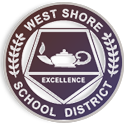The West Shore School District is committed to a Comprehensive Literacy approach. Components of a Comprehensive Literacy Framework include:
- Read alouds
- Shared reading
- Guided reading
- Independent reading
- Word study
- Interactive writing
- Shared writing
- Independent writing
- Guided writing or writers’ workshop
- Writing aloud
Within each of these components, certain knowledge, strategies, and skills can be explicitly taught.
Reading aloud involves the sharing of good literature that engages the young learner, improves language and vocabulary acquisition and opens up the world of reading for enjoyment. Read alouds provide opportunities for children to practice listening skills and helps them develop strategies important for different types of listening and speaking, including the ability to predict outcomes, visualize, and link to elements of writing. Additionally, students develop the ability to make personal connections with the text, make predictions, and adjust for new meaning as stories progress.
Shared Reading
Shared reading involves a group of children and the teacher sharing in the reading and rereading of a common text. It could be a story, a song, or a poem. The teacher invites the children to pay close attention to the print and read along. Materials that have rhyme or have rhythm and repetition ensure that children will be able to predict language features. Shared reading also provides the opportunity for teachers to model different strategies.
Guided Reading
Guided reading usually occurs in small groups and enables a teacher and a group of children to talk, read, and think their way purposefully through a text. The teacher selects and introduces the text with a small group of children who have similar needs and strengths. Guided reading leads children to understand that reading is a process of actively constructing the author's intended meaning and allows for teachers to support students while they are reading.
Independent Reading
Independent reading provides time for children to read a text without the need of teacher support. Texts available should be those that are easy for children to read and as interesting as possible. Learning First Alliance (2000) cites the National Academy of Sciences as recommending that students read "well-written and engaging texts that include words that children can decipher to give them the chance to apply their emerging skills.” [The report] further recommends “children practice reading independently with texts slightly below their frustration level and receive assistance with slightly more difficult texts” (p. 8). These texts could include those chosen for guided reading.This time given allows students the needed practice of sustained reading behavior on continuous text
Word Study
In word study activities, teachers provide opportunities to help children notice and use letters and words. The goal of word study is for students to use word study strategies as they read and write continuous text. These activities include spelling, punctuation, letters, letter cluster sounds, word parts, etc.
Writing
Reading, writing, talking and listening, are interwoven. Teachers need to understand the interconnectedness of these processes and teach in an integrated way.
Interactive Writing
Interactive writing involves children in the writing process. The teacher and child interact and compose messages and stories together using a "shared pen" technique.
Shared Writing
Shared writing is a cooperative activity in which the teacher and child work together to write messages and stories. The teacher supports the process as they scribe.
Independent Writing
Children write on their own, including stories, informational texts, retellings, labeling, speech balloons, lists, etc.
Guided Writing or Writers’ Workshop
Children engage in writing an assortment of texts. The teacher facilitates the process and provides instruction through mini-lessons and individual conferences. For more information see Writing Workshop: The Essential Guide (2001) by Ralph Fletcher and JoAnn Portalupi.
Writing Aloud
Writing aloud occurs when the teacher writes in front of students and verbalizes what she is thinking and writing. As children observe the teacher in the act of writing, the teacher makes explicit what she is doing: thinking, formatting, layout, spacing, handwriting, spelling, punctuating, and vocabulary. Writing on large chart paper or the chalkboard, the teacher verbalizes her thought processes.
